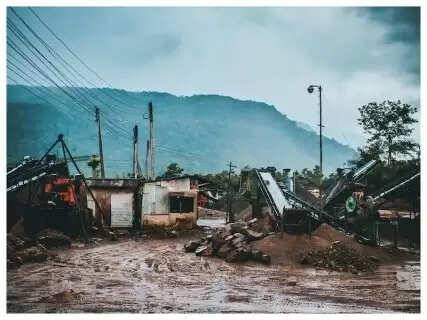
A cloudburst is an extremely intense and localized rainfall event, typically defined as more than 100 mm (about 4 inches) of rain falling within a short period, usually an hour, over an area of approximately 20 to 30 square kilometers. These events are often accompanied by thunderstorms and can lead to sudden, devastating flash floods and landslides, especially in mountainous regions.How Cloudbursts Occur:Cloudbursts are primarily driven by specific meteorological conditions, often amplified by geographical factors:Orographic Lift: In mountainous areas like the Himalayas, as seen in the recent Uttarakhand incident, warm and moist air masses are forced upwards along the slopes of mountains. As this air ascends to higher altitudes, it cools rapidly. This cooling causes the water vapor within the air to condense into tiny water droplets, forming dense cumulonimbus clouds.Accumulation of Water: Strong upward air currents within these thunderstorm clouds can hold large quantities of suspended water droplets and ice particles, preventing them from falling to the ground immediately.Sudden Downpour: When these upward currents weaken or cease, the accumulated water is released all at once. This results in a massive, concentrated downpour over a small area, characteristic of a cloudburst.Atmospheric Instability: The rapid mixing of warm, moisture-laden air with cooler air at higher altitudes can also create unstable atmospheric conditions, leading to sudden, heavy precipitation.Monsoon Dynamics: During monsoon seasons in India, monsoon clouds traveling from the Bay of Bengal or the Arabian Sea gain moisture. When these clouds encounter the steep slopes of the Himalayas, they are forced upwards rapidly, intensifying the process of condensation and leading to cloudbursts.Why Mountainous Regions are Prone to Cloudbursts:Topography: The complex terrain of mountains funnels moist air upwards rapidly, enhancing the orographic lift and subsequent rainfall.Concentrated Runoff: The concentrated nature of rain on mountain slopes directs water into valleys and gulleys, causing sudden and destructive floods.Climate Change: Rising global temperatures can increase the atmosphere's moisture-carrying capacity, potentially leading to more frequent and intense cloudbursts.It is important to note that while the term "cloudburst" suggests clouds bursting like balloons, this is a misconception. The phenomenon is essentially an extreme form of rainfall caused by specific atmospheric conditions.[3] In some instances, events reported as cloudbursts, especially in glacial regions, might also be linked to Glacial Lake Outburst Floods (GLOFs), where water stored in glacial lakes is suddenly released.
Around the web

